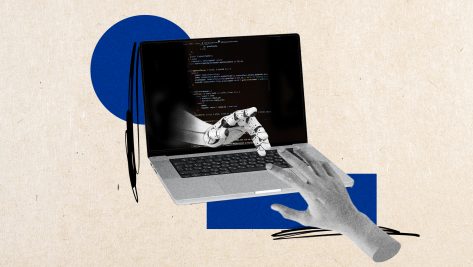The development of infrastructure has historically been a cornerstone of civilization. From the first set of roads that allowed the connection of urban population centers, to the telecommunication networks that span the globe today, these public goods have been vital to facilitate the flow of people, money, and information that has led to so much human advancement. Think of how the Agora became the center of business, social, and political life in ancient Greece or, more recently, how the Internet allowed us to connect the world through the advent of e-commerce, social media, and digital news.
Now, as we head deeper into the future, we need a new set of digital infrastructures to unlock countries’ socioeconomic development and address the interlocking challenges of tomorrow. Digital technologies have the potential to deliver innovation and contribute to the benefit of society, but they have often remained fragmented and unscalable due to their failure to communicate with other parts of their ecosystem. If we are to empower individuals and achieve our strategic objectives, we need solutions that are socially desirable, technically feasible, and economically viable. But how can we build digital infrastructure in a way that harnesses the full power of society while maintaining a high degree of innovation, adaptation, and scalability?
One answer lies in a new form of public-private partnership that has recently taken hold in India: foundational digital public infrastructures (DPIs). The country has embarked on a mission, called India Stack, to build digital platforms as a public good and foster a collaborative environment for both public and private sector entities, which has helped to bring hundreds of millions of citizens into the formal system and onto a path of technological disruption. Through India Stack, an interoperable platform that allows the “stacking” of programs on top of each other to address a wide range of social problems, the country has been able to solve “economic primitives” and completely transform its digital ecosystem in a matter of years.
So, what are the origins of each of India Stack’s three layers – identity, payments, and data – and how exactly do they benefit the Indian population – and furthermore, what lessons can other economies, both emerging markets and advanced, learn from India’s success?
Identity Layer
India’s digital journey began in 2009, when the recently established Unique Identification Authority of India (UIAI), created Aadhar, a program to give the country’s 1.4 billion citizens a unique biometric identity. Until then, millions of people did not have a physical document to prove they were who they claimed to be, which hindered the provision of basic services. Undocumented Indians faced difficulties when trying to access welfare benefits and tax credits, let alone requesting a credit card or applying for a mortgage. But thanks to a Herculean public outreach campaign, the Indian government eventually reached 99% of the population and showed the world how rapid technological innovation can have a leapfrogging effect.
The premise was simple, a unique 12-digit identity number to prove a person’s name, date of birth, gender, and address. Yet Aadhar rapidly became a foundational document, providing public authorities with a bedrock for the digitization of government schemes and private sector companies with the information needed to engage in contractual agreements. The system served well during the Covid-19 pandemic, when it was used to facilitate the transfer of social safety net payments to those who needed it the most. And it also helped accelerate the country’s progress towards financial inclusion, by speeding up the identification requirements for opening bank accounts and allowing to increase the share of Indian adults with access to banking services from 35% in 2011 to 80% in 2017.
Indeed, the revolutionary potential of Aadhar was ubiquitous. As Nandan Nilekani, who led the rollout of the application, explains, “Aadhaar by itself could only prove your identity. However, plugging Aadhaar into multiple programs supercharged the overall welfare delivery experience for both governments and residents.” Using identity as an enabler, Aadhar allowed the public and private sectors to offer new e-authentication services, including customer verification, digital signatures, and document repositories. But by encouraging Indians to participate in the full spectrum of socioeconomic activity around them, what Aadhar achieved was more akin to a Cambrian explosion of all sorts of innovative new products and services.
Payments Layer
The second step came with the development of India’s Unified Payment Interface (UPI), a fast payment system (FPS) providing frictionless, affordable, safe, and timely transactions to ordinary citizens. Launched by the National Payments Corporation of India (NPCI) in 2016, the platform effectively granted every mobile phone user unfettered access to digital payments that are settled instantly, on demand, and in fiat currency. From a 10-cent cup of tea to a $2 bag of vegetables, digital payments are now widely accessible for the Indian population to a level unseen in many of the world’s most advanced economies; a major behavioral shift in what had traditionally been a largely cash-driven economy. Indeed, as noted in a recent New York Times article, “[b]illions of mobile app transactions — a volume dwarfing anything in the West — course each month through a homegrown digital network that has made business easier and brought large numbers of Indians into the formal economy.”
The platform has also grown rapidly, completely disrupting the country’s digital payment sphere. UPI is now used by over 300 million individuals and 50 million merchants and, by 2023, it had settled more than eight billion transactions worth nearly US$200 billion, 50 percent of which are classified as small or micropayments. Adoption has been particularly high in the e-commerce and retail sectors, but also in other areas such as health and agriculture, where fast payments have been enabled by a wide range of innovative use cases.
Overall, the service has brought large efficiencies to smaller merchants, who thanks to near-field communication (NFC) and quick-response (QR) code payments have been able to expand their customer base and document their cash flow, thus extending the reach of tax collection and improving access to banking services. But this new system also created an immense amount of financial information that risked being siloed at the expense of the public good. This raised an urgent need for a safe and convenient means for data sharing and paved the way for a new legal framework for data fiduciaries.
Data Layer
The success of India’s foundational DPI approach ultimately made the country incredibly data rich, so to prevent the unfair capture of personal information by public or private sector entities, the government established the Data Empowerment and Protection Architecture (DEPA) to enable the seamless and secure flow of information. The goal was to build “a consent-based data sharing system to actualize the benefits of DPIs and empower the citizen with a real ability to control data.” In practice, this has allowed individuals to access the information generated by their online activity and, most importantly, dictate their terms for sharing it, thus helping businesses to leverage the power of data without compromising users’ right to privacy.
India’s success rests on its foundational building blocks approach.
Indeed, DEPA succeeded at inverting the surveillance capitalist model in favor of a new framework in which data is used to unlock valuable insights. This required the creation of a new type of organization called Consent Managers (CM); data fiduciaries who enable data principals (users) to give, withdraw, review, and manage their consent through an accessible, transparent, and interoperable platform. These CMs allow people to provide granular consent for every piece of data they decide and ensure it is used responsibly and sustainably, by storing users’ information securely and sharing it to those who can make the most productive use, which has eased the perennial mismatch between data supply and demand that exists today.
In turn, this has also helped create a more competitive environment, as it has allowed new players to access data from information providers without having to set up exclusive (and expensive) bilateral data-sharing agreements. One of DEPA’s crown jewels has been the Account Aggregator (AA) framework, a network of regulated entities which collect financial information from users and share it with other regulated financial institutions in the network, thereby creating a sort of market for credit providers. Thanks to its efficient governance structure, this abundance of information has helped “banks, tax authorities, insurers, and other finance firms […] to get better understanding about their potential customers, make informed decisions and ensure smoother transactions.” For the moment, most applications have focused on the financial sector, but DEPA presents opportunities for greater empowerment in health, jobs and urban data as well.
Foundational DPIs have the potential to transform emerging markets and advanced economies alike. The case of India offers valuable insights for policymakers and carries important lessons that are relevant and applicable to countries at any stage of development. Its Aadhar program effectively granted every resident a national digital biometric identity and substantially expanded their access to basic banking and financial services. Its UPI system has allowed the country to enhance payment efficiency and increase tax collection without compromising innovation. And its legal framework for data fiduciaries has ensured that individuals can readily access the data generated by their online activity and dictate the terms for sharing it.
In a nutshell, India’s success rests on its foundational building blocks approach, which has been guided by four basic principles, i) providing digital infrastructures as a public good, ii) encouraging private innovation by providing open access to these infrastructures, iii) creating a level-playing field through a robust regulatory framework, and iv) empowering individuals through a data-sharing framework that requires their consent. Another factor has been India’s focus on unbundling solutions to a set of problems and identifying minimal common cores, or economic primitives. Its ‘stack’ approach has also provided the country’s digital infrastructures with great flexibility, as each platform addresses a unique need, but when put together, they create a powerful bundle of applications; independent yet highly interoperable single-purpose technologies that can work together towards common goals.
However, two caveats should be noted when considering the lessons from India. First, as some observers have argued, it is likely that the country was able to make this astonishing technological leap “because it had little legacy digital infrastructure in place”. Unlike many advanced and developing economies, India could develop its digital ecosystem with a clean slate, which may have facilitated the rollout of foundational DPIs. Indeed, the complex web of established digital stakeholders in many countries makes it difficult to apply India’s model as a one-size-fits-all solution, especially considering the many conflicting interests and asymmetric power relationships that exist today. Secondly, India’s system has raised significant data privacy concerns as DPIs have become embedded in people’s everyday lives. Many individuals worry about state-sponsored DPIs because if a not-so-benign government ever took power, it could quickly turn them into tools for monitoring and surveillance, thus eroding individual freedoms. Good DPIs require strong legal safeguards to achieve policy objectives while protecting people’s rights, and while it is true that India has adopted a robust techno-legal approach to circumscribe the state’s ability to access people’s personal details, continuous care should be taken to ensure that potential abuses remain impossible.
© IE Insights.











